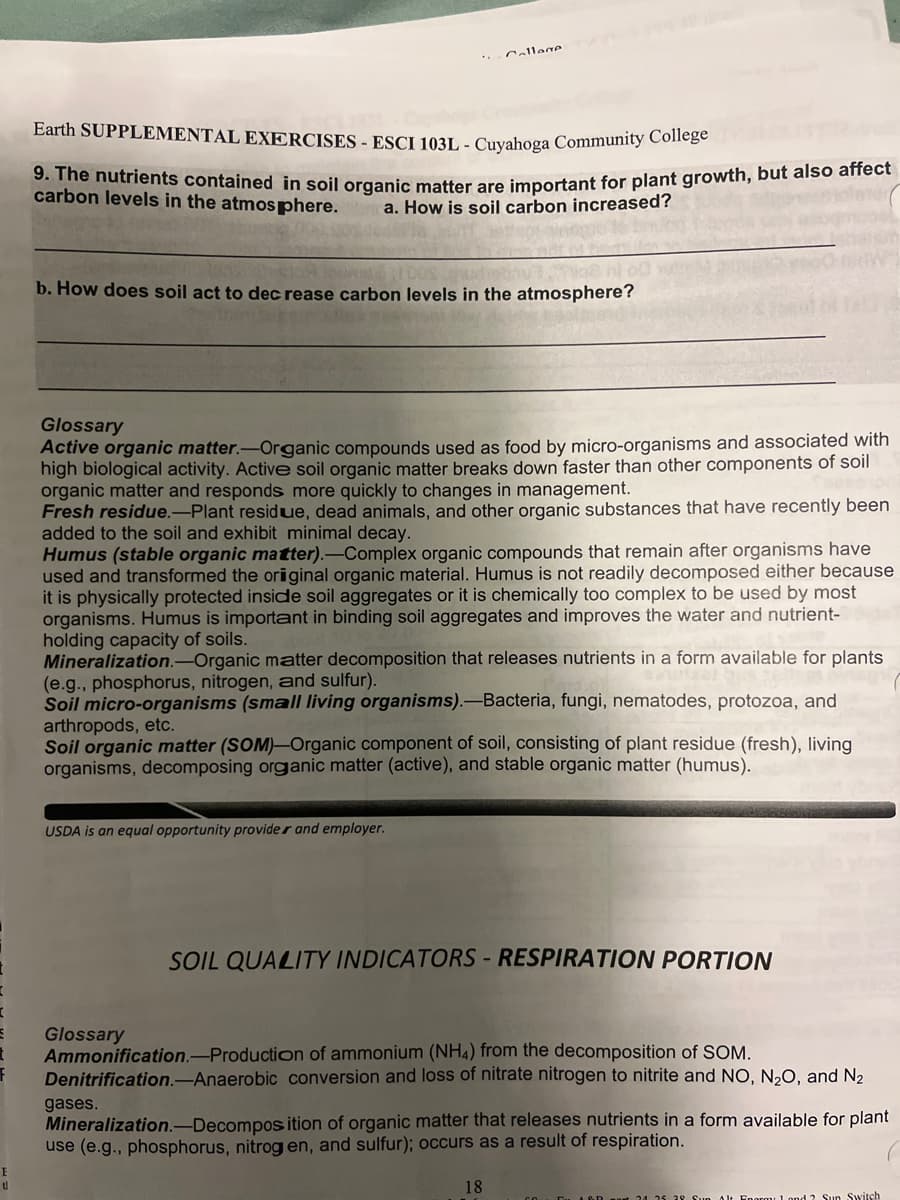The nutrients contained in soil organic matter are important for plant growth, bon levels in the atmosphere. a. How is soil carbon increased?
The nutrients contained in soil organic matter are important for plant growth, bon levels in the atmosphere. a. How is soil carbon increased?
Applications and Investigations in Earth Science (9th Edition)
9th Edition
ISBN:9780134746241
Author:Edward J. Tarbuck, Frederick K. Lutgens, Dennis G. Tasa
Publisher:Edward J. Tarbuck, Frederick K. Lutgens, Dennis G. Tasa
Chapter1: The Study Of Minerals
Section: Chapter Questions
Problem 1LR
Related questions
Question
Answer the following question to best of your ability

Transcribed Image Text:I
E
ป
Callane
Earth SUPPLEMENTAL EXERCISES - ESCI 103L - Cuyahoga Community College
9. The nutrients contained in soil organic matter are important for plant growth, but also affect
carbon levels in the atmosphere.
a. How is soil carbon increased?
b. How does soil act to decrease carbon levels in the atmosphere?
Glossary
Active organic matter.-Organic compounds used as food by micro-organisms and associated with
high biological activity. Active soil organic matter breaks down faster than other components of soil
organic matter and responds more quickly to changes in management.
Fresh residue.-Plant residue, dead animals, and other organic substances that have recently been
added to the soil and exhibit minimal decay.
Humus (stable organic matter).-Complex organic compounds that remain after organisms have
used and transformed the original organic material. Humus is not readily decomposed either because
it is physically protected inside soil aggregates or it is chemically too complex to be used by most
organisms. Humus is important in binding soil aggregates and improves the water and nutrient-
holding capacity of soils.
Mineralization.-Organic matter decomposition that releases nutrients in a form available for plants
(e.g., phosphorus, nitrogen, and sulfur).
Soil micro-organisms (small living organisms).-Bacteria, fungi, nematodes, protozoa, and
arthropods, etc.
Soil organic matter (SOM)-Organic component of soil, consisting of plant residue (fresh), living
organisms, decomposing organic matter (active), and stable organic matter (humus).
USDA is an equal opportunity provider and employer.
SOIL QUALITY INDICATORS - RESPIRATION PORTION
Glossary
Ammonification-Production of ammonium (NH4) from the decomposition of SOM.
Denitrification.-Anaerobic conversion and loss of nitrate nitrogen to nitrite and NO, N₂O, and N₂
gases.
Mineralization.-Decomposition of organic matter that releases nutrients in a form available for plant
use (e.g., phosphorus, nitrogen, and sulfur); occurs as a result of respiration.
18
24 25 28 Sun Alt Enorm 1 and 2 Sun Switch
Expert Solution
This question has been solved!
Explore an expertly crafted, step-by-step solution for a thorough understanding of key concepts.
Step by step
Solved in 3 steps

Recommended textbooks for you

Applications and Investigations in Earth Science …
Earth Science
ISBN:
9780134746241
Author:
Edward J. Tarbuck, Frederick K. Lutgens, Dennis G. Tasa
Publisher:
PEARSON

Exercises for Weather & Climate (9th Edition)
Earth Science
ISBN:
9780134041360
Author:
Greg Carbone
Publisher:
PEARSON

Environmental Science
Earth Science
ISBN:
9781260153125
Author:
William P Cunningham Prof., Mary Ann Cunningham Professor
Publisher:
McGraw-Hill Education

Applications and Investigations in Earth Science …
Earth Science
ISBN:
9780134746241
Author:
Edward J. Tarbuck, Frederick K. Lutgens, Dennis G. Tasa
Publisher:
PEARSON

Exercises for Weather & Climate (9th Edition)
Earth Science
ISBN:
9780134041360
Author:
Greg Carbone
Publisher:
PEARSON

Environmental Science
Earth Science
ISBN:
9781260153125
Author:
William P Cunningham Prof., Mary Ann Cunningham Professor
Publisher:
McGraw-Hill Education

Earth Science (15th Edition)
Earth Science
ISBN:
9780134543536
Author:
Edward J. Tarbuck, Frederick K. Lutgens, Dennis G. Tasa
Publisher:
PEARSON

Environmental Science (MindTap Course List)
Earth Science
ISBN:
9781337569613
Author:
G. Tyler Miller, Scott Spoolman
Publisher:
Cengage Learning

Physical Geology
Earth Science
ISBN:
9781259916823
Author:
Plummer, Charles C., CARLSON, Diane H., Hammersley, Lisa
Publisher:
Mcgraw-hill Education,